Watch video (above): Kaleidoscopic colour
There’s no shortage of photographic gear and gadgets on the market. Although while we often justify a new lens with an ability to open up new creative possibilities, we don’t always give accessories the same time of day. This month I’ve been experimenting with the Fractals Filters Classic 3-Pack, which at £170 / $129 may sound a tad steep, but like a new lens, they open up brilliant artistic opportunities and allow you to take unique pictures.
These prism filters can be held in front of the lens to refract and reflect light in interesting ways. Some create a glitchy pattern while others create a kaleidoscope of colour, making them perfect for portraits – giving your shots an edge that will stand out from the crowd. Of course, cheap prisms can be bought online for £10/$10 and are a great place to start, but if you want better quality and versatility, these Fractals Filters are certainly worth it.
1. Use a 50mm prime lens
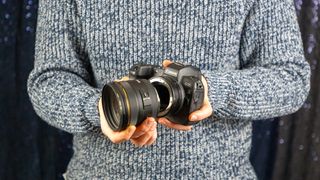
Start by attaching your lens to your Canon EOS camera; 50mm on a full-frame Canon, or 35mm on an APS-C, seems to be the sweet spot but you can, of course, experiment. Make sure your lens is fitted with a UV filter so that you don’t scratch the front element.
2. Starting settings
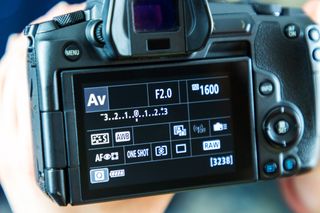
To begin, go into your Canon’s Aperture Priority (Av) mode and dial in an aperture of f/2 and ISO1600. You’ll want to aim for a shutter speed of at least 1/200 sec to eliminate camera-shake, so you may need to tweak your ISO value depending on daylight levels.
3. Move the filter around

First compose your scene and have your model pose as desired, and check the exposure is good. Then, compose again but bring your prism into view this time. Try moving it closer or further away from the lens and tilting it towards or away from your model.
4. Face Detection

Autofocus can be a challenge when shooting through a prism. On newer Canons like the EOS R5, Subject Detection (above) makes this much easier. But for older Canons you’ll need to place your active AF point over the model’s eyes to make sure they are sharp.
5. A helping hand
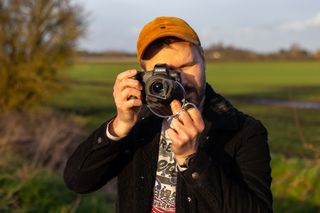
Holding your camera in one hand and a filter in the other can be tricky, so we suggest it’s easiest to hold the Fractals Filter by its grip and then use your thumb to rest against the lens barrel to steady yourself, and help you line up the shot perfectly. It’s also worth enabling any lens or body-based Image Stabilization on your Canon EOS to help reduce camera shake too. A tripod can be a better option if you don’t need the flexibility of moving and shooting quickly, although it’s a good option for shooting video footage with prisms.
6. Not all 50mm lenses are created equal

A 50mm lens offers the perfect focal length for prism portraits, but one thing to look out for is the front element. This Canon RF 50mm F1.8 STM front element is just 43mm, so we needed to move the filter away from the lens to see more of its effects.
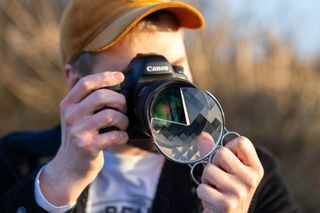
The diameter for the front element of this Sigma 50mm f/1.4 lens is much larger at 77mm. This means we can hold the Fractals Filter closer to the lens to squeeze in the effect of the prism. As we can hold it closer to the lens it’s much easier to blur using a wide aperture and shallow depth of field.
7. Fractals Filters: Pascal

The Pascal is the heaviest of the three prism filters in the Fractals Filters Classic 3-Pack. Tipping the scales at 255g it’s a bit more unwieldy to use than the others. Master it though, and it will allow you to take ‘impossible’ images, as its chunky glass element has been cut in such a way that allows it to reflect objects from outside your normal field of view. When you’re shooting outside, this could be a tree directly behind you! Our model wore a sparkly dress in front of a blue glittery background for extra sparkles that has reflected in the glass.
8. Fractals Filters: Julia
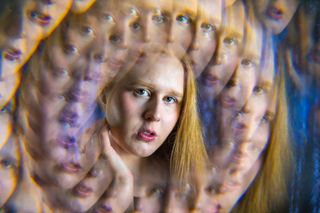
The Julia filter is perfectly circular with the Fractals Filters signature knuckle-duster style metal grip so you can hold it comfortably in your left hand, while holding your camera in your right hand. It has an orange segment style pattern cut into it with a clear circular sweet spot in the centre. This used to be an actual hole but is now one complete piece of glass for cleaner results. This central zone gives you an ideal ‘sweet spot’ in which to position your model’s face, with the surrounding frame then being filled with a mesmerizing kaleidoscopic view.
9. Fractals Filters: Penrose

The Penrose filter is the lightest of the trio in the classic 3-Pack with its thin proportions and a section of glass cut out from it. This makes it a joy to use as it can be held and repositioned with ease. The glass has a checkerboard pattern on its front face, breaking the surrounding scenery into a wonderful diffused, glitchy pattern. The cutaway section of glass is ideal for placing your focal point as it leaves this area perfectly sharp. Due to its two pointy ‘horns’, make sure a UV filter is fitted to your lens to avoid scratches to the front element.
PhotoPlus: The Canon Magazine is the world's only monthly newsstand title that's 100% devoted to Canon, so you can be sure the magazine is completely relevant to your system. Every issue comes with downloadable video tutorials too.
Get the Digital Camera World Newsletter
The best camera deals, reviews, product advice, and unmissable photography news, direct to your inbox!

Deputy Editor on PhotoPlus: The Canon Magazine, Dan also brings his technical wizardry and editing skills to Digital Camera World. He has been writing about all aspects of photography for over 10 years, having previously served as technical writer and technical editor for Practical Photography magazine, as well as Photoshop editor on Digital Photo.
Dan is an Adobe-certified Photoshop guru, making him officially a beast at post-processing – so he’s the perfect person to share tips and tricks both in-camera and in post. Able to shoot all genres, Dan provides news, techniques and tutorials on everything from portraits and landscapes to macro and wildlife, helping photographers get the most out of their cameras, lenses, filters, lighting, tripods, and, of course, editing software.
